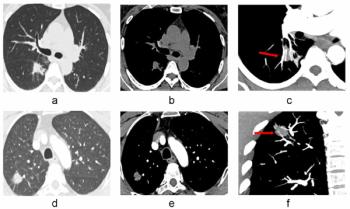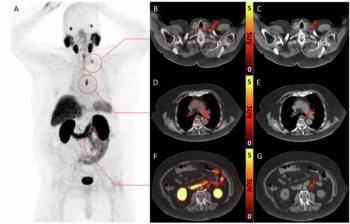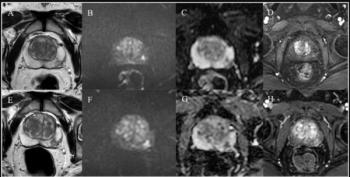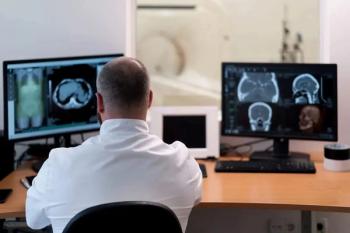In the specialized domain of diagnostic imaging, computed tomography (CT) stands out for high-resolution imaging capabilities that offer detailed visualization of internal anatomy. The X-ray source, represented by the X-ray tube, is one of the key components in CT systems. Accordingly, let us take a closer look at the X-ray tube and the importance of X-ray filtration to optimize image quality and radiation dose management.
Filtration in the X-ray tube is essential to modulate the energy spectrum of X-rays, improving image contrast and reducing noise. This process not only increases the diagnostic quality of the images but also plays a crucial role in reducing the radiation dose to which patients are exposed. By using filters of specific materials, such as aluminum or tin, it is possible to optimize the balance between image quality and radiation dose.
Accurate selection and use of filters in the X-ray tube can significantly influence both diagnostic quality and patient safety, providing radiologists and radiologic technicians with crucial information for optimizing CT imaging procedures.
The generation and shaping of the X-ray beam are fundamental. The beam is generated by the emission of electrons from a cathode, accelerated toward an anode made of tungsten, rhenium, and/or molybdenum. These materials create an X-ray spectrum with photons over a wide range of energies with a maximum energy determined by the tube's peak voltage (kVp). However, once this theoretical beam passes through the human body, it may not be optimal for diagnostic imaging due to beam hardening, a phenomenon that can alter the average attenuation coefficient, affecting the stability of Hounsfield units and potentially creating artifacts in the image. To mitigate these problems, modern CT scanners use both software correction methods and pre-patient filtration techniques. These filters absorb low-energy photons, thus reducing the patient's dose level.
Specialized filters and advanced spectral shaping represent a crucial aspect of CT technology. These filters, including bowtie filters, play a fundamental role in optimizing image quality and managing radiation doses by shaping the X-ray beam, due to their unique shape. Thicker at the edges and thinner in the center, these filters adapt to the various morphologies of the human body. Their design effectively addresses the aforementioned beam hardening, which occurs when X-rays are partially absorbed as they pass through the body, altering the average attenuation coefficient. This can cause inconsistencies in Hounsfield units and the creation of artifacts in the image. By absorbing low-energy photons, major contributors to noise, these filters significantly reduce inconsistencies with Hounsfield units and resulting artifacts.
Ensuring Optimal Dose Efficiency
Another crucial advantage is the management of radiation doses. X-rays with shorter intersecting lengths through the patient tend to be less absorbed, varying the detected signal and, in the worst cases, saturating the detector. By modulating the intensity of the beam, bowtie filters contribute to a homogeneous distribution of image noise and radiation dose. Furthermore, they improve the scatter-to-primary ratio, reducing the number of photons incident on the peripheral parts of the body, thereby decreasing scattered photons and, consequently, reducing noise and artifacts in the final image.
The technology of tin filters, introduced by Siemens Healthineers, has had a notable impact in spectral shaping for CT imaging. Chosen for their excellent physical properties, these filters optimize the X-ray spectrum, improving the signal-to-noise ratio (SNR) and reducing diagnostic uncertainty, especially at 100 kV. The reduction of image noise and radiation dose contributes significantly to patient safety and diagnostic accuracy.
Dose efficiency is crucial in screening programs, such as those for colorectal or lung cancer, in which radiation is a delicate issue. The technology of the tin filter is suitable not only for lung imaging but also in clinical scenarios in which dose efficiency is crucial, especially for non-contrast exams. The combination of the tin filter and low kV on a single scanner offers a powerful duality.
Emerging Advances with Filters and Spectral Shaping
In addition to the benefits in dose efficiency, spectral shaping with the tin filter also reduces patient-induced beam hardening, improving the suppression of bone hardening or artifacts from metal implants or casts. In musculoskeletal imaging, this translates into optimal visibility of bone structures or metal implants and their immediate surroundings, although it reduces bone contrast in some way. The tin filter provides an alternative to metal artifact reduction methods based on reconstruction, not recommended in certain scenarios, and does not prolong reconstruction time or clinical workflow.
With the advancement of CT technology, various suppliers have begun to offer bowtie filters in various shapes and sizes that are customizable for the specific anatomical needs of patients. The correct positioning of the patient within the scanning field is crucial to fully exploit the effectiveness of these filters, avoiding artifacts and ensuring the best image quality.
To meet this need, some CT system manufacturers have introduced the use of 3D cameras, designed to ensure isocentric and standardized patient positioning. This advanced tool captures the shape, position, and height of the patient in three dimensions, thus facilitating the optimization of the radiation dose specifically targeted at the organs, and simultaneously improving the quality of the images. This holistic and cutting-edge approach constitutes a qualitative leap in the personalization and effectiveness of diagnostic imaging.
In dual energy imaging, the combined use of tin and gold filters brings innovations in spectral shaping. By eliminating low-energy photons, the tin filter enhances material differentiation and spectral separation, which is essential for reliable material decomposition. This increases dose efficiency and improves image quality. The SOMATOM go. platform (Siemens Healthineers) comes standard with the tin filter, which can be activated or deactivated depending on the user's needs or specific scanning protocols. As a result, spectral shaping becomes more flexible and precise, leveraging untapped potential in reducing radiation dose and artifacts for dedicated CT applications where mid-energy photons are not of interest.
Another approach has been to shape the spectrum in the opposite direction, reducing high-attenuation photons and enhancing the low kV spectrum. Gold (Au) has a K-edge at 81 keV so X-ray photons with energy just above this K-edge are strongly absorbed by pre-filtration with a gold filter as opposed to low-energy photons in the spectrum. This filtration behavior differs from previously mentioned filters, such as the tin filter. With gold filters, the average energy of the X-ray spectrum is shifted to lower energies in contrast to a higher energy shift with filtration materials like tin (Sn). Thanks to these different characteristics, a combination of gold and tin filtration through the X-ray beam allows for dual energy spectral imaging based on a single tube voltage. This technology was introduced as part of the TwinBeam Dual Energy solution, configured as a movable split filter with one half in Au (gold) and the other half in Sn (tin).
The Philips imaging system uses the IntelliBeam 'wedge filter,' which stands out for its variable thickness, being particularly thinner in the center with only 2.11 mm of aluminum. This specific feature of the filter is fundamental for the uniform distribution of the X-ray beam across the patient during CT scans. The design of this wedge filter was precisely studied to improve image uniformity. Accordingly, the images produced are of high quality with fewer distortions and greater clarity, thus facilitating a more accurate and reliable diagnosis. Furthermore, the wedge filter significantly reduces the radiation dose in the peripheral areas of the patient's body.
Three Key Takeaways
- X-ray filtration optimization for image quality and patient safety. The article emphasizes the critical role of X-ray filtration in computed tomography (CT) imaging, specifically with materials like aluminum or tin. Proper filtration modulates X-ray energy, enhancing image contrast, reducing noise, and ultimately improving diagnostic quality. This optimization not only benefits image quality but also plays a crucial role in minimizing patient radiation exposure.
- Bowtie filters for dose efficiency and artifact reduction. The use of specialized filters, such as bowtie filters, is highlighted as a key aspect of CT technology. These filters, with their unique design, address challenges like beam hardening, contributing to both image quality and patient safety. By modulating the intensity of the X-ray beam, bowtie filters enable a more homogeneous distribution of image noise and radiation dose.
- Innovative approaches to spectral shaping and artifact reduction. The article outlines novel strategies in spectral shaping, particularly with the integration of tin and gold filters. The use of Siemens Healthineers' SOMATOM go. platform exemplifies how this technology enhances material differentiation and spectral separation, leading to increased dose efficiency and improved image quality. The combination of gold and tin filtration for dual energy spectral imaging allows for a unique shift in the X-ray spectrum, offering more precise control over radiation dose reduction and artifact management.
Canon Medical has recently introduced a removable silver filter. The company’s SilverBeam is an innovative technology for CT that uses the attenuation properties of silver to remove low-energy photons from a polychromatic X-ray beam. This process optimizes the energy spectrum for low-dose chest exams, making it particularly suitable for screening and diagnostics, especially in lung cancer screening.
Integrated with the deep learning reconstruction algorithm AiCE, Silver Beam improves image quality by reducing noise and radiation dose. It is also effective for patients with larger body sizes and complex anatomical regions, offering an optimal balance between dose reduction and maintaining image quality. Silver Beam represents a significant step toward safer and more effective CT diagnostics, reducing patient exposure to radiation and improving the quality of imaging.
Another type of upstream patient filter is the post-collimation filter to avoid scattered radiation. In this case, GE HealthCare’s Revolution Apex model has a 3D filter at 160 mm with inclination in the three axes to eliminate disturbances as much as possible.
United Imaging implements the use of advanced bowtie filters in its radiological imaging systems. These filters, available in three specific sizes, are designed to optimize X-ray beam filtration for specific applications. The body imaging filter is designed to maximize image quality while reducing unnecessary radiation absorption, whereas the head imaging filter is optimized for the resolution of fine details of the skull and brain. The cardiac filter, on the other hand, balances image quality and minimization of radiation dose, which is essential for repeat cardiac imaging procedures. Furthermore, these filters are adapted for both adult and pediatric applications, with particular attention to reducing radiation exposure in younger patients.
NAEOTOM Alpha (Siemens Healthineers) photon-counting CT uses both bowtie and tin filters.
Final Notes
In conclusion, advanced filtration and spectral shaping play a fundamental role in improving image quality and managing radiation doses for CT exams in daily clinical practice.
Giuseppe Scappatura is a radiology technician at the UOC of Radiology of the Grand Metropolitan Hospital in Reggio Calabria, Italy. He is an integral member of both the multidisciplinary CAR-T therapy team and the multidisciplinary prostate cancer team. Mr. Scappatura has played a pivotal role in coordinating diagnostic procedures related to COVID-19. The author can be reached via e-mail at: giuseppe.scappatura1970@gmail.com































